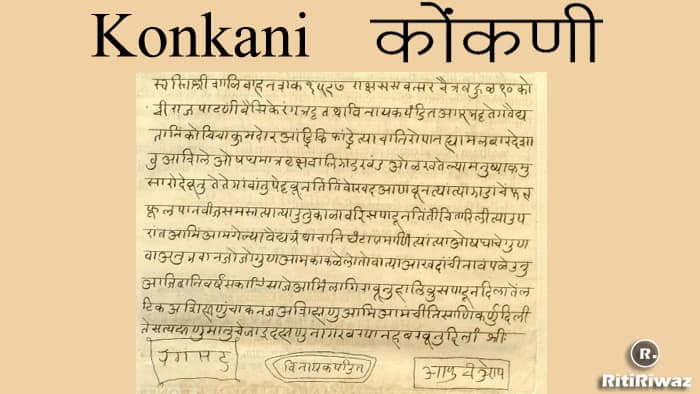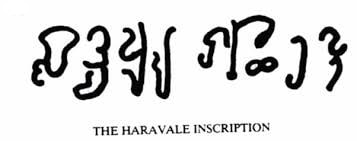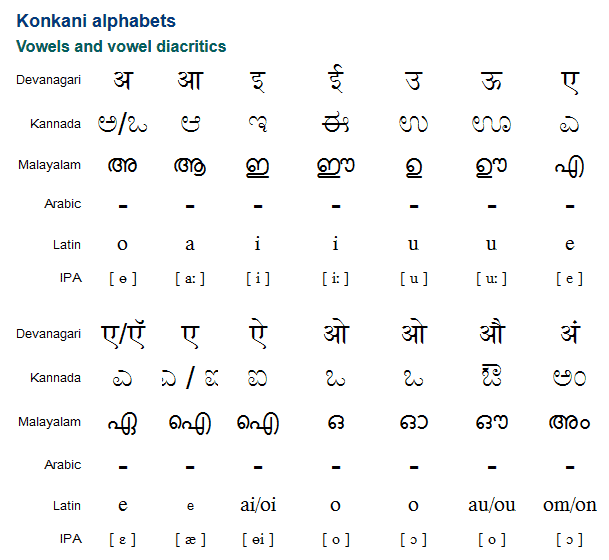Konkani Language

Konkani language is spoken in the state of Goa, and throughout the Konkan coastline of India. It is also spoken in the neighboring states of Maharashtra, Karnataka, and Kerala.
Konkani is ages old and is derived from Sanskrit like most Indian languages. Unsurprisingly, this language has no script and is only spoken. Devnagari script (which is used in most north Indian Languages) was adopted as the official script for Konkani. The beauty of this language is that it sounds very sweet, and sentences have a rhythm to it like you are almost singing it.
The word “Konkani” is used to describe both a language of the Indian subcontinent and a group of people. It is derived from “kum”, meaning “Mother Earth” and “Kana”, meaning ‘dust’ or ‘atom’. Thus, Konkani would mean “a part of Mother Earth“. This appellation could well describe the hardy people of the Konkan region, who are primarily farmers and fishermen.
History

The journey of Konkani ancestors did not complete within a day or two. It took centuries and so did the language it took many forms and was inspired by many languages. When our ancestors resided in Trihotrapura they came in contact with other languages such as Maithili, Magadhi, and Ardha Magadhi with a result that a new language, Konkani took shape.
Thus when they reached Goa, it appears along with Sanskrit they had taken Konkani also, and Konkani began its evolution as a vernacular form of Sanskrit. Konkani did not show any traces of the influence of any other language till around the 16th century.
The earliest inscription in the Konkani language is of the Gupta period and is found at Arvalem in Goa. The inscription reads: “Sachipuracha Sirassi” (on the top of Sachipura). Only this sentence of the whole inscription is legible. It is ascribed to the 2nd century A.D. A photostat copy of it was published in the Canara Industrial and Banking Syndicate Bank’s Silver Jubilee Souvenir of the Sirsi Branch, 1959.
One other inscription has been found, which goes back to the 12th century. The entire inscription is not in Konkani, but only one or two sentences are in that language, the rest being in Marathi. It is an inscription of the Silahara King Aparaditya of the year 1166 A.D, and it has the following Konkani’s sentence “atha tujo konu-hurie shasonlapi techya vedyanatha-devachi bhal sakutumid apader”. This is a north Konkan inscription at Nageshi dated Saka 1334 (1413 A.D.) is not completely in Marathi language. It is an inscription of Virapratapa Deva Raya I of Vijaynagar under whom Nanjanna Gosavi was Governor in Goa.
Konkani used to be written in the Nagari script during the Portuguese and Dutch periods. Konkani unfortunately has been compelled to become a language using a multiplicity of scripts – Devanagari, Roman, Kannada, and Malayalam, and is not just one single script used everywhere. This has led to an outward splitting up of the same language, which is spoken and understood by all, in spite of some inevitable dialectal divergences e.g. Ratnagiri Konkani, Goan Konkani of the Christians and of the Hindus, south Kanara Konkani, and Kerala Konkani. There are many organizations that came into being in different states for the promotion of the Konkani language and get the language its due place among the national languages of India. With the recognization of Konkani in 1975 by Sahitya Akademi, a new era dawned.
Goa, first in India to be occupied by a European power, was the first to have a printing press and Konkani thus enjoys the privilege of possessing the first text printed in aby Indian language. Hence Konkani became the first Asian language ever printed, in the first volume published by the first press set up in the continent, in Goa in 1556. Later, the first modern grammar book of any Indian language was Arte da Lingoa Canarim, published in 1640 by pioneering English Jesuit Thomas Stephens. By the middle of the 17th century, there was a substantial body of Konkani literature in print, described by Fordham University’s late polymathic linguist and scholar Jose Pereira as “a great achievement…far in advance of any modern Indian tongue”.
Post-Independence Period
Following India’s Independence and its subsequent reconquest of Goa in 1961, Goa was absorbed into the Indian Union as a Union Territory, directly under central administration. However, with the reorganization of states along linguistic lines, and growing calls from Maharashtra, as well as Marathis in Goa for the merger of Goa into Maharashtra, an intense debate was started in Goa. The main issues discussed were the status of Konkani as an independent language and Goa’s future as a part of Maharashtra or as an independent state(see Konkani-Marathi Controversy). A plebiscite retained Goa as an independent state in 1967. However, English, Hindi, and Marathi continued to be the preferred languages for official communication, while Konkani was sidelined.
Konkani Language Writing
The western coast of India is popularly referred to as the Konkan coast. The culture is distinct, with its own food habits and festivals. The language is from the Devanagari script, which is common in India. But there are dissimilarities as well, as Konkani has been influenced by Portuguese over the years when Goa was a colony of Portugal. The Portuguese ruled Goa for 450 years till 1961 when it was finally freed.

Approximately 7.4 million people speak the language in India, many of whom are in Goa. It is a minority in other states and union territories – Kerala, Maharashtra, Karnataka, Dadra, and Nagar Haveli, and Daman and Diu. Goa is the only state where it is a majority. Almost everyone will understand in Goa, even if they cannot write in the language.
There are some similarities between the two alphabets, because they are both Indo-Aryan, and follow the Devanagari script. Many alphabets look similar and serve the same purpose. But not all of them are the same. There are some unique alphabets.
- There are 44 letters in the Hindi alphabet. In Konkani, there are 52.
- In Hindi, there are 33 consonants and 11 vowels, but in Konkani, there are 36 consonants and 16 vowels.
But in spite of these differences, the language follows a Sanskrit structure, like Hindi.
Konkani used to follow the Brahmi script once, but it’s not in use anymore. Now it is written in Devanagari, and to some extent in Malayalam, Kannada, Roman, and Persian scripts. The Devanagari script is recognized as the standard.
Suggested Read: Goa – Culture, and Tradition
Konkani Dialect
Konkani, despite having a small population shows a very high number of dialects. The dialect tree structure of Konkani can easily be classified according to the region, religion, caste, and local tongue influence.
The term “Konkani” when applied to a person or a community can have two distinct but sometimes overlapping meanings
1. The Konkani speaking community
2. The people of the Konkan region comprise the Konkan administrative division of Maharashtra state and Goa.
The Konkani has been categorized on basis of historical incidences and cultural influences. Broadly speaking, thee major groups have been formed and these are as follows:
Northern Konkani: comprises of dialects spoken in the Ratnagiri district of Maharashtra who has established cultural links with Marathis.
Central Konkani: It comprises of dialects of Goa, where Konkani was highly influenced by the Portuguese language and culture.
Southern Konkani: constituents of all the dialects of the Canara region of Karnataka having a close links with Tulu and Kannada.
Ethnologue(ISO) too brought out its categorization. These are as follows: The ‘ISO 639-3’ assorts ‘Konkani generic macro language(ISO 639-3: kok)’ into ‘Goan Konkani (ISO 639-3: gom )’; ‘Konkani (individual language) (ISO 639-3: knn)’ This ‘ISO 639-3: knn’ constitutes of numerous dialects and these are namely ‘Agari of Kolaba; Parabhi (Kayasthi, Damani); Koli; Kiristav; Dhanagari; Bhandari; Thakuri (Thakari, Thakri, Thakua, Thakura); Karhadi; Sangamesvari (Bakoti, Bankoti); Ghati (Maoli); Mahari (Dhed, Holia, Parvari);
On the other hand, the dialects that constitute Goan Konkani (ISO 639-3: gom) are namely, ‘Sarasvat Brahmin’, ‘Standard Konkani (Goan)’, ‘Bardeskari (Gomantaki)’, ‘Kudali (Malvani)’, ‘Mangalore’,’Daldi (Nawaits)’, ‘Chitpavani (Konkanasths)’.
‘ISO 639-3’ incorporates several languages and also dialects in the Konkani language. Although they may not be esteemed as dialects of Konkani, they are rightly considered to be sister languages.
Konkani Language Writing System
People write Konkani in many different scripts(writing systems or alphabets). People from different regions use different scripts. Konkani people from Goa and Maharashtra use the Devanagari script. Konkani people from Karnataka use the Kannada script. People in Goa use Roman script. Konkani Muslims use Arabic script. Konkani people from Kerala use the Malayalam script. Devanagari is the official script.
English Konkani Translation
I speak a little Konkani – Aoo thodee Konkani ooloyta
Can you help me? – Mhojem modot korshi?
I come from (place) – Mau zo gao ( place)
How do I go there? – Thuim hao kosso vossoonk
How much to (place)? – Vossoonk kitley pot ollay
Where can I make a phone call? – Maka phone karonc khuim meltolem
Please Upkar koroonc
What is the charge per day? – Eke dissak kitley poi shay?
Thank you Deu borem Korum






